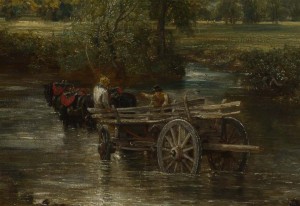Q: What Were the Wainriders Like?
ANSWER: J.R.R. Tolkien provides very little information about the Wainriders, who began attacking Gondor in the 1800s of the Third Age. They and their successors, the Balchoth (balc + hoth), were Gondor’s greatest foes for about 700 years. In The Lord of the Rings Tolkien wrote:
…The Wainriders were a people, or a confederacy of many peoples, that came from the East; but they were stronger and better armed than any that had appeared before. They journeyed in great wains, and their chieftains fought in chariots.
The only other significant detail I can find is published in Unfinished Tales, in the section titled “Cirion and Eorl”, where Tolkien writes:
The revolt planned and assisted by Marhwini had indeed broken out; desperate outlaws coming out of the Forest had roused the slaves, and together had succeeded in burning many of the dwellings of the Wainriders, and their storehouses, and their fortified camps of wagons….
Some people have suggested to me that perhaps the Wainriders were inspired by the Mongols, but that seems counter-intuitive. While it is true that Mongol tribes used to travel across the deserts and steppes with tents (yurts) mounted on great wagons drawn by many cattle, these rolling homes were not (to the best of my knowledge) used in warfare. It’s not clear to me if the wagon-mounted yurts were common homes or were only used by wealthier Mongols. Yurts could be disassembled and transported on camel-back or in small wagons. Yurts are still used in some parts of Asia today.
Fortified camps built from circles of wagons are attested at least as far back as the 4th Century CE in Europe (the Goths used them to defend against Romain armies) and the 2nd Century BCE in China. J.R.R. Tolkien would have been very familiar with all the extant accounts of Gothic wagon-forts and their successes (and failures) when used against Roman armies. Two more recent uses of the wagon-fort concept were implemented by the Czech Hussites in the 15th Century CE and the Voortrekkers of South Africa (the Laager formation). Tolkien was probably familiar with the history of both movements. However, none of these examples provides any insight into Tolkien’s use of wain.
It appears there is general confusion over the meaning and application of wain, which is derived from the same ancient root-word tree as wagon. A wagon is a well-known vehicle, especially to American film and television audiences, and many different types of wagons have been depicted in art and literature through the years. Wagons and carts have been used for thousands of years. Chariots, which carried the war-chiefs of the Wainriders and Balchoth, were also used for a couple thousand years before falling out of fashion as cavalry tactics and equipment improved. The last major use of war-chariots in European history most likely occurred in the failed British rebellions against the Romans in the 1st Century CE. Celtic chariots, in fact, carried chiefs and nobles and were supported by the common warriors (on foot). These charioteers bear a clear resemblance to Tolkien’s Wainrider chieftains.
It seems to me that the Wainriders therefore combine several historical and martial traditions and should not be viewed as closely modeled on any true historic peoples. The tactical superiority of wagon-forts over traditional cavalry forces would explain why the Northmen and Gondor had so much trouble with the Wainriders. Although Tolkien does not go into detail, the eventual defeat of the Wainriders had to be due to a change in tactics and strategy by Gondor and its allies; yet even so, Tolkien says the battles were intense and their outcomes were in question for many hours.

To be effective as an invasion force the Wainriders would have to be mobile as a people as well as in war. The use of wagons and carts to transport their goods and families across large open steppes makes sense. But the use of wagon-forts suggests that they may have a special use for wains as opposed to mere wagons. Historically a wain was a type of wagon which was used for load-bearing tasks and not really “ridden” by drivers. English painter John Constable (1776-1837) is best known for a painting called “The Hay Wain” (first exhibited in 1821). The painting depicts a common wain which does not appear to have been suitable for use as personal transportation or even for long journeys such as settlers or colonists made in America and Africa.
Assuming that Tolkien was both familiar with and inspired by Constable’s work, he might have extrapolated a sort of “war-wain” technology for the Wainriders, whereby they would construct wains intended solely for uses as components of mobile fortified camps; and these war-wains could have been built to present a considerable tactical challenge to the Northmen and Gondorians for several centuries. Perhaps he might have envisioned such war-wains holding oversized bows (such as ballistae) which might have conferred additional advantages upon the Wainriders. The Wainriders might thus be viewed as an imaginary people who blended real historical traditions from Gothic, Celtic, Hussite, and Voortrekker tradition. If that is the case it would explain why people have struggled to produce conclusive arguments in favor of any single sources.
# # #
Have you read our other Tolkien and Middle-earth Questions and Answers articles?
